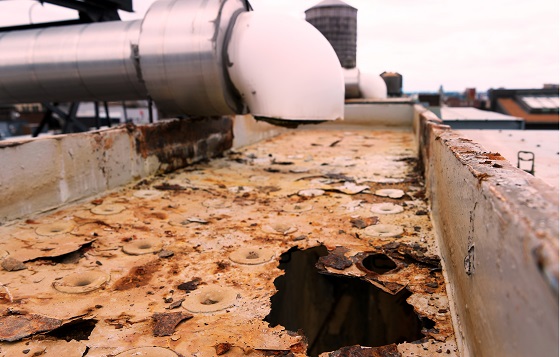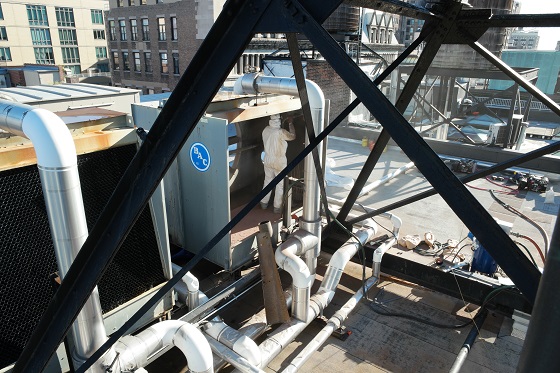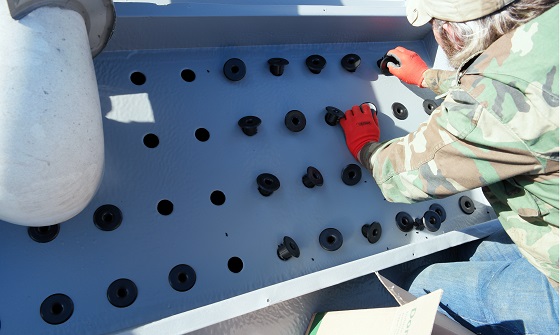Coatings can be found in many different industries and areas around the world. They’re commonly seen on bridges, water tanks, and rooftops, to name a few. But it’s a different kind of rooftop project where coatings company Southeastern Industrial Linings has found its niche. The company of three — father David Puckett, brother Randall, and David’s son Brandon — focuses on cooling towers.
“We went after this niche market, the cooling tower market, because it was just simply being underserved,” Puckett explained.
They’re based out of the Atlanta, Ga., area, but they’re called upon by customers from around the country via their website. “Everything comes off our website,” David Puckett said.
Southeastern Industrial Linings also coats wastewater treatment assets, floors, and other assets where polyurea coatings are a suitable solution. But, in particular, they’ve figured out how to serve the rooftop cooling tower market.
The key, according to Puckett, is mobilization. “When we’re doing these large buildings, we have to take everything with us to the roof,” he said. “That’s the blasters, the spray equipment — everything has to go to the roof with us.” Instead of renting cranes, depending on road closures, and hauling traditional equipment up top, the company invests in screw compressors, which offer a smaller and more portable option to work their equipment off of.
On a recent project in Manhattan, the crew not only had the solution for three severely rusted and leaking cooling towers, but they also had some of the best views of the city. Being 11 stories up gave the crew a memorable Empire Building backdrop — and more.
Leaks and Fixes
According to Puckett, cooling towers are routinely subjected to cleaning chemicals, which keep bacteria out that can cause Legionnaires and other diseases. Those chemicals are harsh and also expensive. Over time, if the steel degrades and leaks, that could lead to a loss of water and chemicals, as well as an increase in further damage onto the roof. “It’s a bad thing all the way around,” he said.
Unfortunately, Puckett said, the amount of work that will be necessary for cooling towers is a bit of a mystery, at first. “You never know what you’re going to get until you start blasting it,” he said.
On this job, the towers were each about 20 years old and severely pitted. The crew, therefore, needed to do much more than just prep and paint in some areas. “What we had to do was cut that whole frame out, because it was completely rotted out,” Puckett said. “It was just pouring water out of it, completely rotted away.” Some areas could just be taped on the outside and sprayed in for proper protection. Then other areas, such as the pans, needed that complete replacement. The crew swapped out completely corroded steel with locally fabricated sheet metal. After that, they sprayed those sections with the rest of the towers. “Rebuild the component with equipment that’s readily available,” he said.

Each of the three towers had 250 to 300 square feet (23.2–27.9 m2) of galvanized steel. In total, that added up to about 750 to 900 square feet (69.7–83.6 m2) of work. The three Puckett family members and a fourth person covered the two-week job, which was completed for Rosini Engineering out of Long Island City, N.Y.
Through the Roof
Southeastern Industrial Linings’ first task was to get everything to the roof. On a 100-year-old building, there were a few hurdles, of course. For starters, the building’s top three levels were a restaurant with no rooftop elevator access. Instead, hatches served as access to the top. As a result, the crew had to haul all of the prep and spray equipment, blasting media, drums of the coatings, and two compressors up through three stories of hatches. “It was a nightmare,” Puckett said succinctly.
Ideally, compressors would be 400 CFM (679.6 m3/hr.). “But when you’re on the roof, that’s just not an option,” Puckett said. “You’re using something closer to 200 CFM [339.8 m3/hr.]. We put a smaller blast nozzle and pushed the pressure back up, so you’re blasting slower when you’re on these roofs than you would be when you’re on the ground.”
It took the crew at least a full day of work just to get everything through the roof before they could even start working on prep, to which they had a multi-faceted approach.
To achieve a NACE No. 2/Society for Protective Coatings (SSPC) Surface Preparation (SP) 10, “Near-White Metal Blast Cleaning,” the crew didn’t need to do much. The steel was pitted and “pretty rough to start with,” Puckett said. On steel that didn’t need to be replaced completely, they removed the rust and prepped using a Graco EcoQuip 2EQm Mobile Blast System with CHLOR*RID and GMA Garnet abrasive included. The crew prefers that equipment, of course, due to it being more lightweight than other options. The compressors’ combined efforts through hoses that led to one blast hose feeding the blaster.

Using CHLOR*RID wasn’t the only idea this crew utilized to help hold the blast. The crew used a primer to help there, too. Although polyurea doesn’t require a primer, Southeastern Industrial Linings does use it on occasions where they might need to mitigate humidity or other variants. They then bagged up any spent abrasive materials.
Prep work took about a day and a half. From there, the crew moved on to coating. For that stage, they donned Tyvek suits, hood socks, and full-face respirators. They used a two-step primer process: an average of 5–7 wet mils (127.0–177.8 microns) of Sherwin Williams CC-A2 Industrial Wash Primer, which is an etching primer, followed by another 5–7 wet mils of the VersaFlex VF-20 Modified Urethane Primer. That gave the crew time to come back with the polyurea, which was applied to an average of 60 mils (1,524.0 microns). The Polyshield-HT 100F polyurea from Specialty Products, Inc. (SPI), a VersaFlex company, went down in 20-mil (508.0 microns) passes using a Graco E-XP2. That gels in around 6 seconds and is cured in about 24 hours.
Once the coating was cured, the crew was able to install new rubber nozzles for the tower’s motor.
Bright Lights, Big City
In New York, wintertime work includes short and often cold days. The Southeastern Industrial Linings crew experienced only a day or two of delays due to bad weather. It wasn’t the snow that stopped them, though. They use salamander heaters and tarps to keep the substrate — and crewmembers — at the right temperatures. But working with polyurea means no work when it rains. That’s because water on the surfaces can cause a layer of disbondment of the polyurea, meaning it wouldn’t stick to the substrate.
During the project, they did get front row seats for one of New York’s most popular events: “We were up there working on the other building over Thanksgiving,” Puckett said. “It was snowing, and we were actually watching them terminate the Thanksgiving Day Parade right at the bottom of the building that we were on.”

They say real estate is all about location, location, location. You can’t beat a view of both the Empire State Building and the famous Thanksgiving Day parade. Considering this project resulted in three leak-free towers, too, that’s one positive experience all around.
Read the member ProFile on the VersaFlex families in the May 2021 digital issue.